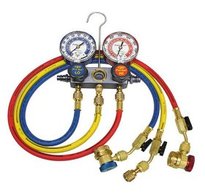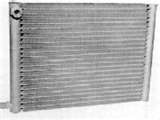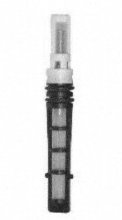Car AC Diagnostics

It may seem crazy to talk about car AC diagnostics in the middle of a snow storm. But by the time this page gets indexed and ranked you should be ready to turn on your vehicles air conditioning for the first time after a long winter of not using it.
On a previous post about air conditioning auto repairs I discussed how to test your system using manifold gauges. We also discussed how important the total charge of the system is to air-conditioning performance.
On this page will be some tips on how to deal with pressure readings that are out of specifications. Also included will be some best practices for Car AC diagnostics as well as running system AC performance testing properly. And don’t forget to wear safety equipment because freon is dangerous.
High side pressure readings
When you’re basing your diagnostics off of system pressure it is very important to refer to the pressure charts in your online auto repair manuals. These pressure readings will vary greatly with humidity and outside temperature.
Improper diagnosis is often caused by expecting an unrealistic reading on a hot humid day. With that said if you have determined that your pressure readings are truly off here are some tips on what they could actually mean.

If the high side pressure is too high there could be air in the system, too much refrigerant, or a restriction in the high side of the system. Also poor airflow across the condenser can cause excessive high side readings.
Poor airflow across the condenser can be caused by a radiator fan not working properly or even debris or bugs caught in the condenser fins. In either case the airflow problem must be corrected before further testing takes place.
If the highside pressure is too low the most likely cause would be a low refrigerant level. But also a defective compressor can also cause a high-side pressure not to reach its full potential. Worn parts inside the compressor can cause this but it is recommended to assure the proper amount of Freon is in the system before condemning the compressor or replacing it.
Low side pressure readings
When diagnosing AC, low side readings are often the most critical to the output temperature of the system. To follow are a few examples of how to evaluate improper low side pressure readings on your Cars AC. If the low side pressure is higher than normal the most likely cause would be a refrigerant overcharge or a defective compressor. As mentioned above it is best to remove all of the Freon from the system and then specifically charge the correct amount before determining a bad compressor.

As mentioned on my car AC information pages on the YouFixCars.com website the manufacturer provides an exact amount of Freon that belongs in the system. This is usually indicated on an under hood label in most cases either on the radiator shroud or on the heater case on the firewall side of the engine compartment.
If the low side pressure is lower than normal and it has been determined that the correct amount of Freon is in the system a metering device could be problem or cause. On most General Motors vehicles they use an orifice tube metering device.
It is not uncommon for this to become restricted and cause low side readings to be below specifications. Other manufacturers will have different types of metering devices although the orifice tube has become the most common type of Freon metering component.
Also note that the orifice tube has a screen on it that can become clogged. If your orifice tube is clogged it is most likely from either moisture in the system or failure of internal components that have been chewed up and spit out by the compressor. If this screen is clogged with metal chips the system should be flushed thoroughly before recharging.
Automotive A/C diagnostic tests
A rundown of automotive AC diagnostics. The procedure will vary with your problem but here is an overview of how I would approach performance testing a system. I start by connecting the manifold gauge set to the respective high and low pressure fittings again you can find the location of service fittings in your service manual.
Close all the doors and windows and set up a fan in front of the radiator to simulate going down the road. Also to simulate road conditions it is recommended to raise the idle to about 1500 to 2000 RPMs. Now you can take accurate pressure readings on the high and low side and compare them to specifications.
You can also take an AC temperature output reading at the center duct with the blower on a medium speed or lower. With the pressure readings and the output temperature recorded this will give you a good baseline to start your diagnostics. Tree charts in your auto repair manual will guide you through the specific repair of problems indicated by your readings.

